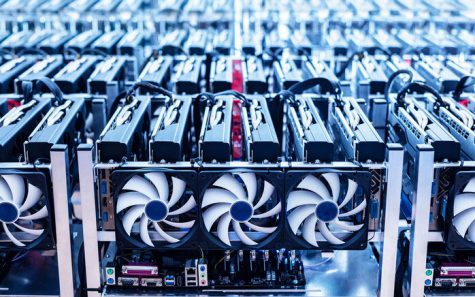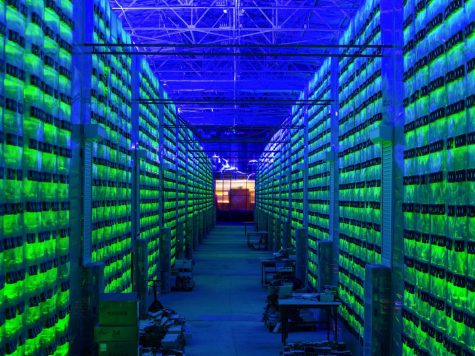Digging Deep for Cryptocurrency
October 10, 2021
Throughout history, people have used a system of bartering to trade with others to satisfy their needs. As civilization evolved, this rudimentary bartering evolved into currency, which is essentially the use of money to trade for goods and services. Starting in 2009, currency took a big step towards the future: it became digital. These digital currencies were named “cryptocurrencies,” with the first one being Bitcoin. To this day, Bitcoin is the most prominent and successful digital currency, but many others, such as Ethereum and Dogecoin, also exist. The only way to obtain cryptocurrency is to buy or mine it.
Cryptocurrencies are essentially just virtual money; think of them as digital coins. They often take the form of stock, so the value of a singular coin is variable. Since most online things are easy to clone or fake, cryptocurrencies have a built-in mechanism to give them worth: they are almost impossible to obtain. They are so difficult to acquire that the production or discovery of new currency became known as cryptocurrency mining.
The process of “mining” cryptocurrency consists of computers trying to solve an extremely complicated mathematical equation to find a “block.” A block of a cryptocurrency contains a certain number of coins, such as fifty bitcoins. Claiming a block requires being the first computer to solve the equation, an equation so complex that even computers will struggle to find the answer. Once the block has been discovered, the “block-chain” pulls the next block forward, and the process begins anew. In this way, a block can only be used once, and the block-chain is a record of all previously mined cryptocurrency.
The cost of mining cryptocurrency is very high, with an average mining “rig,” a powerful computer, being worth around $2000. However, the better a miner’s system, the higher the chance of them discovering the next bitcoin first, leading many to put even more money into it. Extensive systems solely dedicated to number-crunching for new coins can be worth hundreds of thousands of dollars.
Miners take a gamble that they will mine enough currency to cover the costs of buying and running their rig, which they often achieve through joining coin mining pools. These pools are groups of miners working together to find the next coin, increasing their chances of finding it first. They then split the currency acquired from the block among them, and between them can sustain a steady income of cryptocurrency. Cryptocurrencies are essentially kept alive by their miners: without the desire to find new coins, all of them would lose worth.
An effective mining setup requires either a Graphics Processing Unit (GPU) or Application-Specific Integrated Circuit (ASIC). With the value of cryptocurrencies on the rise, mining has become even more profitable, causing more and more individual GPUs to be bought for the purpose (especially Ethereum mining). So many of these GPU chips have been dedicated to mining cryptocurrencies that other industries are experiencing shortages. Many cars sit assembled in factories but wait for chips to complete them. New car models are being delayed, and it is challenging to find a GPU for even an average PC.
On top of the costs of obtaining a powerful rig, the mining of cryptocurrency consumes massive amounts of energy, adding to costs. According to Havard Business Insider, the mining of bitcoin alone costs 110 TeraWatt hours per year or 0.55% of the world’s electricity production.
People often debate whether mining is a worthwhile use of this energy, with proponents saying Bitcoin is a way to escape inflation and other financial issues, and critics saying that Bitcoin is a money-laundering gimmick. Many environmentalists have also pointed out this extravagant energy use, arguing that it translates into increased carbon emissions. In reality, this is impossible to determine since the source of electricity the miners use isn’t usually disclosed.
In fact, cryptocurrency mining won’t grow out of control and take unprecedented amounts of energy. Cryptocurrencies make it increasingly challenging to find new blocks to avoid exponential inflation of the worth of a coin. If the difficulty of finding a bitcoin in 2009 was 1, now it is over 16 trillion. Some currencies, such as Bitcoin, will also impose a maximum amount of coins, 21 million, and decrease the number of coins rewarded per block discovered over the years. These limitations are how cryptocurrencies retain their worth from a functionality standpoint, but they have the side effect of limiting how big cryptocurrency will get. Eventually, all coins will be mined.
Cryptocurrencies have additional safeguards in place to ensure they are reputable and can be used as currency. In hard currency, the actual money is transferred out of the buyer’s hand. In contrast, everything in cryptocurrency is digital, so theoretically, the same coin could be reused twice. However, undermining the cryptocurrency system is extremely difficult as each block mined is recorded, and miners actively check that duplicates (forgeries) don’t exist. It becomes immediately apparent when two blocks identify as the same when there can only be one, so using a currency’s coin twice is impossible.
Despite these safeguards, cryptocurrencies are still highly volatile. Government policies around the world often affect their worth drastically. Some governments ban their mining entirely because it threatens their financial control of the country. Most governments are distrustful and even impose sanctions on the practice. However, cryptocurrencies are making steady gains despite this, with some companies allowing payment in them and many prominent individuals buying stock in them. It’s not far-fetched to say that one day in the future, cryptocurrencies will be as common as hard money and a daily part of our daily lives.



















